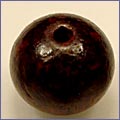History of Wooden Beads
Wood is generally easy to find and work with so wherever wood is found you will find wooden beads. Regional carpenters and carvers use the most readily available species of wood and beadmaking itself was used as exercises for apprentices or as spare time work for journeymen or masters. This wide variety of woodworkers and woods makes for an astonishing variety of forms, sizes, and types of wood beads.
Unfortunately, because these wooden beads are so common they are taken for granted. The amount of printed material on the subject of wood beads is few and far between and the study of common wood beads is not considered a proper subject for serious bead researchers. Much of the background for this article was found on the World Wide Web as advertising banners. Other sources on the Web treat wood beads as adjunct to information on prayer beads or abacus, because they incorporate wooden beads into the finished product.
Types of Wood Use
Most exotic wood beads originate in the Middle East or southern Asia,but Europe is also a source of wood beads. The Czech Republic producesinexpensive pine and bass wood beads for children's toys and macramécrafters, as well as inexpensive wood beads you'd find in bead shopsworldwide.
As with all forms of beads there are a few dedicated artists here in America and elsewhere who revel in making their own wooden beads. These artists collect exotic woods from around the world and carve exquisite and unique types.






